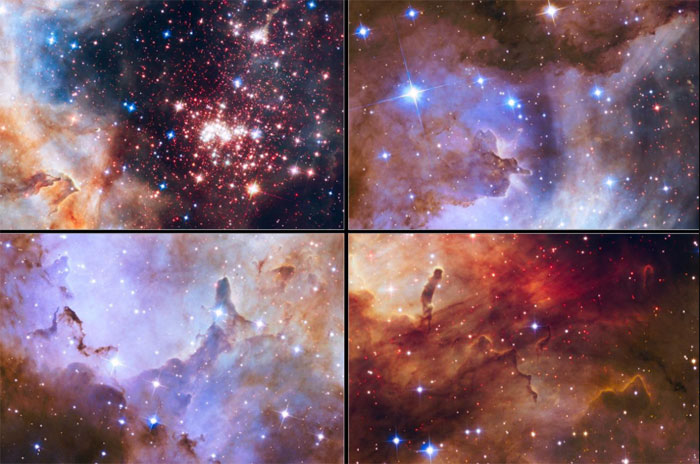New findings on the early universe
New research results from the Hubble Space Telescope show that the formation of the first stars and galaxies in the early universe occurred earlier than previously thought.
The discovery of the first galaxies remains a significant challenge in modern astronomy research. We do not know when or how the first stars and galaxies in the universe formed.
However, it is possible these questions can be addressed with the Hubble Space Telescope through deep visual observations. Hubble allows astronomers to study the universe back within 500 million years of the Big Bang.

The formation of stars and galaxies occurred much earlier than we thought.
A team of European researchers, led by Rachana Bhatawdekar of the European Space Agency, began studying the first generation of stars in the early universe. These stars are made up of original material that emerged from the Big Bang.
Stars in a star population called Stars III must be made of hydrogen, helium and lithium, the only elements that existed before processes in their cores could produce elements. heavier like oxygen, nitrogen, carbon and iron.
Bhatawdekar and his team probed the early universe about 500 million to 1 billion years after the Big Bang by studying the MACSJ0416 cluster and its parallel field with the Hubble Space Telescope with supporting data. from NASA's Spitzer Space Telescope and the Great Southern European Observatory.
"We found no evidence of stars in the first Generation III Star Complex during this cosmic time," Bhatawdekar said.
The researchers' results were obtained using the Hubble Wide-Field Camera 3, as part of the Frontier Fields program. This program looked at six distant galaxy clusters between 2012 and 2017, making the deepest observations ever made from the clusters of galaxies and the galaxies behind them, magnified by the steaming lens. lead, which suggests that galaxies are 10 to 100 times fainter than any previous observations.
The mass of foreground galaxies is large enough to bend and magnify the light from distant objects behind them. This allows Hubble to use this result to study objects that are beyond its performance.
Bhatawdekar and his team have developed a new technique that removes light from dazzling foreground galaxies to form gravitational lenses. This allowed them to explore the lower-mass galaxies ever observed by Hubble at a distance corresponding to when the universe was less than a billion years old.
The lack of evidence for exotic star populations and the identification of many low-mass galaxies support that these galaxies are the most likely candidates for the recombination of the universe. This period of recombination in the early universe was when the neutral intergalactic environment was ionized by the first stars and galaxies.
"These results have profound astrophysic value because they show that galaxies must form much earlier than we think. This also strongly supports the idea that galaxies have mass. low / faint in the early universe is responsible for recombination ' , Bhatawdekar stressed.
In addition, these results suggest that the formation of stars and galaxies occurred much earlier than what could be explored by the Hubble Space Telescope. This leaves an interesting question about further research for the upcoming NASA / ESA / CSA James Webb Space Telescope to study the earliest galaxies of the universe.
- The most impressive findings about the universe in 2012 (2)
- As early as 2.8 billion years the new universe dies, don't be too afraid
- The bright galaxy takes the scientist to the early universe
- The first time the signal of the oldest stars in the universe was detected
- New findings about Alzheimer's disease help early diagnosis and increase healing
- Detecting huge black holes revealing the universe at the age of cradle
- The most impressive findings about the universe in 2012 (1)
- The galaxy cluster is 500 billion billion times heavier than the Sun.
- Discover the oldest disk galaxy
- Discover the oldest galaxy in the universe
- Outstanding archaeological findings in 2019
- Parallel universe theory is not only math, it is verifiable science
 Van Allen's belt and evidence that the Apollo 11 mission to the Moon was myth
Van Allen's belt and evidence that the Apollo 11 mission to the Moon was myth The levels of civilization in the universe (Kardashev scale)
The levels of civilization in the universe (Kardashev scale) Today Mars, the sun and the Earth are aligned
Today Mars, the sun and the Earth are aligned The Amazon owner announced a secret plan to build a space base for thousands of people
The Amazon owner announced a secret plan to build a space base for thousands of people